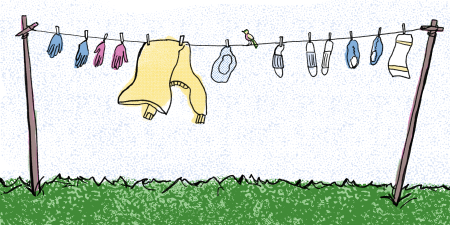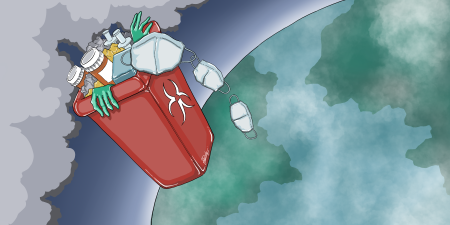Abstract
A warming climate poses substantial risk to public health and worsens existing health inequity. As a contributor to greenhouse gas emissions and air pollution, the health sector has obligations and ample opportunities to protect health by decreasing waste and motivating more system-wide sustainable clinical practices. Such efforts will have important ethical implications for health equity.
Case
City Y has ambient levels of particulate matter (PM) of 2.5, a rate 25% higher than most American cities. The American Lung Association had flagged Y as 1 of 2 cities that fail State of the Air evaluations1 in ozone and PM pollution. Y’s air pollution is due to wood burning, which is common in nearby rural communities; its geographical location downwind from plants that power and process solid waste for 4 larger metropolitan regions in nearby neighboring states; and 3 major academic health centers. Thirty percent of contemporary illnesses (eg, diabetes, asthma, cardiovascular disease, chronic obstructive pulmonary disease, and lung cancer) in Y are attributable to poor air quality. In the United States, communities of lower socioeconomic status are at risk of exposure to higher levels of air pollution than those of higher socioeconomic status,2 and, worldwide, low- and middle- income countries are most at risk.3 Moreover, diseases caused by pollution were estimated to be responsible for 16% of global mortality and 268 million disability-adjusted life years (DALYs) worldwide in 2015.3
Commentary
The evidence is clear that fossil fuel combustion is driving global temperatures upward through the emission of greenhouse gases (GHGs) and worsening air quality via air pollution, both of which pose a major threat to human health.4 Higher levels of GHGs trap excess heat energy within the atmosphere, which has contributed to an approximately 1.01 °C rise in global temperatures since 1880.5 Global warming threatens physical and mental health by increasing the risk of extreme weather events such as heat and drought, increasing the environmental suitability for infectious disease transmission, and threatening food and water availability.4
While GHGs, such as carbon dioxide, are at their highest levels ever recorded,5 air pollution in the United States has improved over the last 50 years, thanks to regulatory legislation, such as the Clean Air Act of 1970.6 Despite these air quality improvements, air pollution remains one of the greatest threats to health, both domestically and globally.3 The Global Burden of Disease Study estimates that air pollution accounted for 6.5 million premature deaths and 167.29 million DALYs globally in 2015.7
Not only do clinicians treat the health sequelae of climate change and air pollution, but also the health care sector contributes to these problems. The US health care sector was responsible for approximately 8.5% of US GHG emissions in 2018, with an estimated median loss of 388 000 DALYs attributable to GHG emissions and toxic air pollutants.8 Of these, health care-related PM and ozone pollution are estimated to have caused the loss of 133 000 to 188 000 DALYs.8 Thus, the health care sector is contributing to an environment that poses a risk to health for those it is entrusted to protect. Here, we discuss the ethical imperative for clinicians to consider the environmental implications of health care waste and introduce several initial waste reduction strategies that align with the delivery of high-quality care.
Exposing Inequity
Global and national DALYs lost annually to diseases attributable to air pollution mask the inequitable distribution of harms. In City Y, the poor air quality relative to other American cities is a compound effect of multiple sources, including 3 major academic centers. But not every person living in City Y is subject to the same risk from air pollution. According to the American Lung Association 2022 State of the Air report, people of color are 3.6 times more likely than White people to live in a county with failing grades for PM and ozone.9 Decades of environmental injustice in cities across the United States have led to inequities in exposure to environmental risk factors. For example, polluting facilities, such as the waste facility referred to in City Y, are more likely to be located close to Black or working-class communities.10 People of low income are at higher risk from the health harms of air pollution not only because of where they live but also because they often have less access to expensive adaptation strategies, including air purifiers and advanced medical care. Outdoor workers, such as agriculture workers and construction workers, are also more vulnerable simply based on the extended amount of time they must spend in a potentially unhealthy environment in order to earn a living.11
City Y highlights a complex challenge for health care. Through care delivery, clinicians aim to improve patient health and reduce health inequity. Yet, like the 3 medical centers in City Y, each health care institution contributes GHG emissions and air pollutants that result in both health harms and worsened health inequity. The health care sector therefore has an ethical imperative to identify solutions that minimize environmental harm to population health while continuing to deliver high-quality care.
Innovative clinicians, policymakers, and administrators have developed and continue to implement a wide variety of strategies to reduce the environmental impact of health care delivery—from improving energy efficiency to reducing transport-associated emissions via telehealth implementation. In the remainder of this paper, we will focus on health care waste, a component of the larger challenge of minimizing environmental harm associated with the health care sector.
Waste Reduction Ethics
Misaligned incentives. In the United States, despite efforts to decouple reimbursement from volume, most health care systems still operate under a fee-for-service model that financially rewards volume. Because hospitals and physicians financially and professionally benefit from higher clinical volumes, clinical care efficiency strategies must be implemented. As highlighted above, unnecessary clinical activity harms the health and well-being of surrounding communities through GHG emissions and pollution. Such environmental harms in turn contribute to disease and injury, the treatment of which further benefits hospitals and physicians—financially and professionally—in a potentially never-ending cycle. Through the complexities of threat multiplication, the most vulnerable communities suffer the greatest health harms in this cycle. Thus, physicians and hospitals have an ethical obligation to minimize unnecessary care and to provide all care in the most environmentally sustainable manner possible.
Patients’ rights and equity. Physician and hospital efforts to reduce waste and promote sustainability are necessary for the protection of patients’ negative right not to be harmed. Endeavoring to minimize the environmental harm of health care waste must become an essential facet of how the medical profession conceptualizes clinician nonmaleficence. Moreover, the disproportionate harm borne by minoritized communities creates an imperative for physicians to curtail unnecessary health care waste to meet their obligation to offer all patients an equitable chance of achieving good health and freedom from disease and injury. Continuing to operate under the status quo is therefore doubly unjust. While the reality of health care delivery to the presenting patient necessitates generation of some waste, the harm associated with that waste disproportionately affects those least likely to access health services. Physicians and hospitals must therefore minimize such waste as much as feasible—by both minimizing unnecessary health care and offering necessary health care in the most sustainable way possible to uphold the standards of justice and equity.
Unnecessary clinical activity harms the health and well-being of surrounding communities through emissions and pollution.
One of the standards of ethical human subjects research, elaborated in the Belmont Report, dictates that the subjects of research must either directly benefit from that research or be meaningfully like future patients who might benefit from that research in order for that research to meet standards of justice.12 We could imagine incorporating a similar criterion for judging the acceptability of a hospital’s waste: if the externalities of a patient’s care harm people meaningfully unlike that patient, the system of disposing of that waste is unjust. Such a conceptualization of equity could inform clinicians’ and hospitals’ engagement in efforts to reduce health care waste.
Waste Reduction Strategies
Health care waste can be conceived of in 2 categories. First, unnecessary or unindicted care is itself a form of waste, including commonplace practices like daily magnesium-level testing and antibiotic therapy for asymptomatic bacteriuria. Second, there is waste associated with appropriate, indicated care. From the byproducts of the manufacturing of necessary supplies to the food waste generated by admitted patients, there are many opportunities to minimize the environmental harms of waste from necessary care.
Unnecessary care. Hospitals and doctors are already regularly scored by the Centers for Medicare and Medicaid Services (CMS) for the quality of their patient outcomes, penalized for providing unnecessary care, and incentivized to provide more efficient care. Such scoring and reimbursement systems are often justified by financial imperatives and quality-of-care goals. But environmental sustainability provides another justification for bolstering and expanding these initiatives.
As clinicians, we can support this effort by implementing the best practices outlined by the Choosing Wisely campaign, which offers data-driven guidance on high-priority areas for reducing common, unindicated testing and therapies.13 Within our institutions, we can work with our respective electronic medical records teams to integrate alerts that flag potential unindicated care choices. At a national level, reimbursement policies should reflect that excess unnecessary care not only reduces quality and increases costs, but also contributes to climate change-driven health inequities.
Solid waste associated with necessary care. As a first step, we can utilize existing guidelines on performing waste audits of our practice spaces to identify high-priority areas for waste reduction. Importantly, with our boots-on-the-ground perspective, we can ensure that any proposed changes align with, rather than impede, care quality and efficiency. Beyond identifying commonly wasted products, waste audits also provide insight into the proportions of different types of health care waste produced. Unlike standard waste, regulated medical waste (RMW), often placed in red bags, must be decontaminated prior to final disposal per Occupational Safety and Health Administration standards.14 The decontamination process is energy intensive, and RMW is often transported off-site to undergo such processing, resulting in significant GHG emissions and air pollution15 in contrast to landfilled standard waste, which slowly releases GHGs into the atmosphere but can leech into the surrounding soil and water sources.16 Overuse of red bags for materials that could be processed in standard waste often occurs due to lack of education and convenience of receptacle positioning. As clinicians, we can help lead RMW education efforts and guide implementation of better waste receptacle positioning to reduce this misuse. Some best practice guidance recommends that institutions reduce RMW to 10% of their waste generation,17 but more data on waste audits in different practice settings with varying case mixes could help define more nuanced targets.
At the institutional level, we can collaborate with administrative and purchasing teams to develop supplier contracts that reduce unnecessary waste from the start. Common examples include transitioning instruction manuals for commonly used disposable devices to electronic formats accessible via QR code and reducing excessive plastic packaging.
Equity in implementation. Regardless of disposal method, the location of disposal facilities is also crucial because nearby communities will always be most negatively affected. When considering the location of a waste incineration facility, equity issues arise when the electricity generated by incineration is distributed beyond the local community suffering the harms of air pollution. Like most heavy industries across the United States, many waste processing facilities are located in minority and poor communities.18 Thus, tracking metrics on method and location of health care waste disposal in addition to overall volume of waste is crucial to building equitable health care waste mitigation policies on both the organizational (hospital or health system) and regulatory (state and federal) levels.
Incentivizing waste reduction. Of course, measuring and rewarding waste reduction would be sensitive to the same pitfalls as existing reimbursement incentives. Waste reduction is likely cost saving in the long-term but would require significant up-front capital costs. Resource-rich hospitals and health systems would be better able to provide sustainable care and therefore would benefit most from a pay-for-sustainability program modeled after CMS’ current pay-for-performance programs. Thus, a sustainability perspective should also be added to efforts underway to measure and reward equity in health care. For instance, the collection and use of ICD-10 Z codes to document social determinants of health theoretically provides Medicare billing benefits to institutions and clinicians who care for marginalized communities, and, as a federal payer, Medicare has tremendous power to set standards within health care.19 Such tracking methods could also be used to identify institutions that warrant financial and resource support in implementing waste reduction strategies.
A Future
We recognize that the ultimate solutions to the health inequities associated with climate change extend well beyond the management of health care waste. Such solutions require industry-wide changes and aligned national policies. We hope that clinicians will find guidance in this piece on meaningful steps they can take to reduce health care waste and that readers will be encouraged to lend their voice to advocating for larger sustainability efforts as a step toward health equity for communities like City Y that exist across the nation.
References
-
State of the Air: most polluted cities. American Lung Association. Accessed February 14, 2022. https://www.lung.org/research/sota/city-rankings/most-polluted-cities
- Brochu PJ, Yanosky JD, Paciorek CJ, et al. Particulate air pollution and socioeconomic position in rural and urban areas of the Northeastern United States. Am J Public Health. 2011;101(suppl 1):S224-S230.
- Landrigan PJ, Fuller R, Acosta NJR, et al. The Lancet Commission on pollution and health. Lancet. 2018;391(10119):462-512.
- Romanello M, McGushin A, Di Napoli C, et al. The 2021 report of the Lancet Countdown on health and climate change: code red for a healthy future. Lancet. 2021;398(10311):1619-1662.
-
Understanding our planet to benefit humankind. NASA Global Climate Change. Updated August 4, 2022. Accessed August 9, 2022. https://climate.nasa.gov
-
Our nation’s air. US Environmental Protection Agency. Accessed May 18, 2022. https://gispub.epa.gov/air/trendsreport/2020/
- GBD 2015 Risk Factors Collaborators. Global, regional, and national comparative risk assessment of 79 behavioural, environmental and occupational, and metabolic risks or clusters of risks, 1990-2015: a systematic analysis for the Global Burden of Disease Study 2015. Lancet. 2016;388(10053):1659-1724.
- Eckelman MJ, Huang K, Lagasse R, Senay E, Dubrow R, Sherman JD. Health care pollution and public health damage in the United States: an update. Health Aff (Millwood). 2020;39(12):2071-2079.
-
State of the Air: key findings. American Lung Association. Accessed November 28, 2021. https://www.lung.org/research/sota/key-findings
- Mohai P, Lantz PM, Morenoff J, House JS, Mero RP. Racial and socioeconomic disparities in residential proximity to polluting industrial facilities: evidence from the Americans’ Changing Lives Study. Am J Public Health. 2009;99(suppl 3):S649-S656.
-
Office of Atmospheric Programs. Climate Change and Social Vulnerability in the United States: A Focus on Six Impacts. US Environmental Protection Agency; 2021. EPA 430-R-21-003. Accessed August 9, 2022. https://www.epa.gov/system/files/documents/2021-09/climate-vulnerability_september-2021_508.pdf
-
National Commission for the Protection of Human Subjects of Biomedical and Behavioral Research. The Belmont Report: ethical principles and guidelines for the protection of human subjects of biomedical and behavioral research. US Department of Health and Human Services. April 18, 1979. Updated January 15, 2018. Accessed March 23, 2022. https://hhs.gov/ohrp/regulations-and-policy/belmont-report/read-the-belmont-report/index.html
-
Choosing Wisely®. Accessed March 25, 2022. https://www.choosingwisely.org/
-
Occupational Safety and Health Administration. Standard 1910.1030: bloodborne pathogens. US Department of Labor. Accessed October 21, 2020. https://www.osha.gov/laws-regs/regulations/standardnumber/1910/1910.1030
-
Cole-Hunter T, Johnston F, Marks G, et al. The health impacts of waste-to-energy emissions: a systematic review of the literature. Environ Res Lett. 2020;15(12):123006.
-
Vasarhelyi K. The hidden damage of landfills. Environmental Center, University of Colorado Boulder. April 15, 2021. Accessed November 28, 2021. https://www.colorado.edu/ecenter/2021/04/15/hidden-damage-landfills
-
Reduce regulated medical waste. Practice Greenhealth. Accessed November 28, 2021. https://practicegreenhealth.org/sites/default/files/upload-files/hhi-booklet-waste-bu_v3.0_a.pdf
-
Nolan L. The link between environmental justice and landfills. ArcGIS StoryMaps. Updated May 6, 2021. Accessed November 28, 2021. https://storymaps.arcgis.com/stories/64d1923708814bd59e7d3d79f03d426f
-
Using Z codes: the social determinants of health (SDOH). Centers for Medicare and Medicaid Services. Revised February 2021. Accessed November 28, 2021. https://www.cms.gov/files/document/zcodes-infographic.pdf



